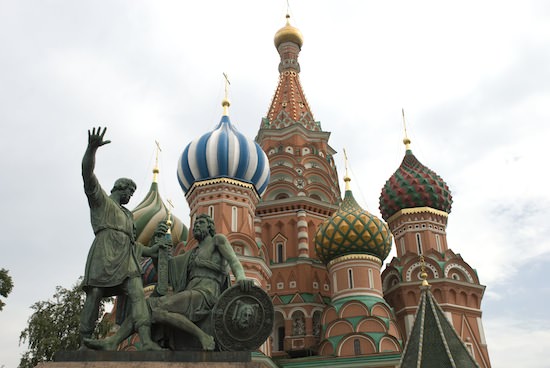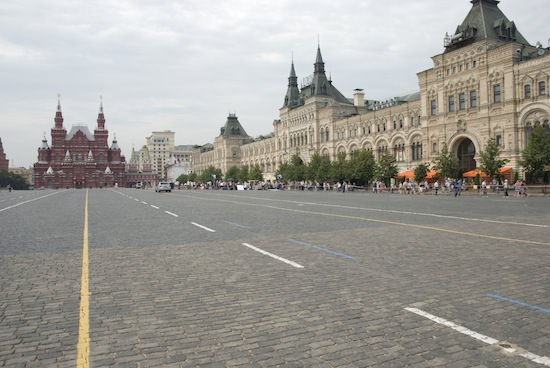Steaming red brick; gold-leafed towers; thumping nightclubs; shady parks: it’s hard to pin down Russia’s capital. Moscow juggles between two identities, as a thriving symbol of the new Russia and the historical center of the old. The Trans-Siberian journey begins in Russia’s capital city. Moscow is big and bold and definitely differs in tone from the rest of the journey. Whether or not Moscow’s fast-paced lifestyle suits you, the city has enough history and culture to entertain – and makes a great introduction to modern Russia.
The easiest way to get around Moscow is by using the extensive Metro system. The beautiful old stations are an attraction in and of themselves – each has a separate décor, with architecture, art, and sculpture contributing to the individual design. The Mayakovskaya Station, an Art Deco masterpiece, features ceiling mosaics detailing Soviet life.
Most people begin at the heart of historical Moscow: the Kremlin. This walled compound holds the country’s religious and civil centers, including the senate buildings and president’s residence. Around the cobblestone of Sobornaya Square cluster several austere gray buildings, topped with gleaming gold onion-domes. The cathedrals of the Annunciation, Assumption, and Archangel mark the center of the Orthodox Church, the spiritual center of Russia.
Inside the cathedrals, painted frescoes cover every wall. The pale faces of saints stare out from boxed scenes. The air smells musty and damp, like wet stone. Unlike some of Europe’s grand Catholic cathedrals, these are smaller, more intimate structures.
In the same complex of buildings, the Armory holds state treasures such as Orthodox icons, bejeweled ceremonial headdresses, and ornate carriages once used to transport royalty. Just outside the square sits the Tsar’s Cannon, an immense weapon constructed to defend the city. The largest cannon ever built, it is nearly 20 feet long.
Edging up against the Kremlin’s outer wall is Moscow’s other famous plaza: Red Square. Bricked in a deep, dried-blood red, the Square has witnessed military parades and rock concerts. It also houses a collection of architecture that rivals any in the world. Flanked by the candy-striped spires of St. Basil’s Cathedral, the ultra-Soviet block tomb of Lenin’s mummy, and the grandiose, palatial GUM department store, Red Square easily takes an afternoon of exploring.
Lenin’s tomb is one of the city’s oddest and most popular sights. The waxy-faced revolutionary lies in perpetual state in a shadowy tomb under the Kremlin walls. The entrance lines are often long.
Across the square, the Glavnyi Universalnyi Magazin (GUM) looks more like a converted mansion than a shopping mall. The inner arcade, topped with a glass ceiling that lets in light, feels miles away from the hot, busy square outside. Originally a trade center, it later became a state-run Soviet department store. It’s an enjoyable, although expensive, place to stroll or have a cup of coffee.
The imposing, brick-red State Historical Museum guards the entrance to Red Square. From bark scrolls to leather shoes to Romanov jewels, the Museum traces Russia’s development from prehistoric to modern. For us, the most fascinating artifacts were those of Russia’s various Siberian cultures, including goblets and pendants, knives, ceramics, and jewelry. Trans-Siberian travelers should peruse the collection, if only to gain an understanding of the historical differences between European Russia and eastern Siberia.
From Red Square, we took a stroll up Tverskaya Ulitsa. Lined by impressive architecture, the theater district is always bustling with activity. Churches, shops, and theaters all line the street, which slopes gently upward away from the Kremlin. The alleys and side-streets off Tverskaya Ulitsa, full of cafes, churches, and restaurants, make for good on-foot exploring.
Gorky Park, on the banks of the Moskva River, has become one of the city’s most popular places. With shady strolls, amusement park rides, restaurants, and roller skating, the park attracts visitors of all ages. Despite the cheesy attractions, Gorky Park has become a chic destination for locals. It has a lighthearted, festive atmosphere that seems almost at odds with Moscow’s brash image. Gorky Park was also the setting for a 1980s thriller of the same name.
Night owls can find plenty of witching-hour distractions in Russia’s capital. Bars and clubs start late and throb with music all night. For those more inclined to violins than DJs, the newly reopened Bolshoi Theater makes a wonderful night out. Home to one of the world’s premiere ballet companies, the Bolshoi symbolizes elegance and culture. After extensive renovations, the famous venue is once again hosting performances – although tickets regularly sell out.
The Trans-Siberian trains depart from Yaroslavsky Station. Two other stations, Leningradsky and Kazansky, are clustered around the same Metro stop within walking distance. Night trains to and from St. Petersburg, which is Russia’s other must-see city, depart from Leningradsky.
Like most transport depots, Yaroslavsky station is not a particularly savory place, but it has left-luggage storage in the basement and basic amenities, such as banking, grocery stores, and subway connections in the immediate surroundings.
Long-distance trains such as the Baikal and Rossiya depart at night. Once the train pulls away onto the long tangle of tracks, the Trans-Siberian journey has truly begun. Moscow’s brash lights fade throughout the night, and by morning, the train is already chugging toward Siberia.
This is part of a series of articles offering advice and travel tips based on Caitlin Dwyer’s experience riding the Trans-Siberian Railway. See her first article, ‘Riding the Trans-Siberian Railway: Planning Your Journey.You may also want to read: How to Apply for a Russian Visa .For ideas about where to stay in Moscow, see our Editor’s Picks for Moscow.
Written by Caitlin Dwyer and Photos by Matt Bozigar for EuropeUpClose.com





